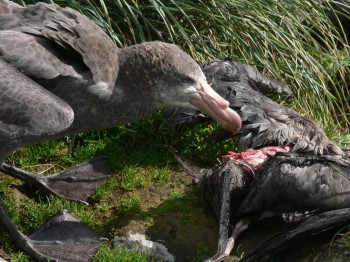Tegan Carpenter-Kling (Marine Apex Predator Research Unit, Institute for Coastal and Marine Research, Nelson Mandela University, Port Elizabeth, South Africa) and colleagues have published open access in the Journal of Experimental Marine Biology and Ecology on bringing together biologging and stable isotope approaches to foraging ecology studies.
The paper’s abstract follows:
“Biologging technologies have revolutionised our understanding of the foraging ecology and life history traits of marine predators, allowing for high resolution information about location, and in some cases, foraging behaviour of wild animals. At the same time, stable isotope ecologists have independently developed methods to infer location and foraging ecology (trophic geography). To date, relatively few studies have combined these two approaches, despite the potential wealth of complementary information.
In marine systems, spatial and trophic information are coded in the isotopic composition of carbon and nitrogen in animal tissues, but interpretation of isotope values is limited by both the lack of reference maps (isoscapes) needed to relate the isotopic composition of an animal's tissues to a location, and the relatively large number of variables that could influence tissue isotope compositions. Simulation modelling can help to interpret measured tissue isotope compositions of migratory animals in the context of spatio-temporally dynamic isotopic baselines.
Here, we couple individual-based movement models with global marine isotope models to explore the sensitivity of tissue δ13C values to a range of extrinsic (environmental) and intrinsic (behavioural, physiological) drivers. We use in-silico experiments to simulate isotopic compositions expected for birds exhibiting different movement and foraging behaviours and compare these simulated data to isotopic data recovered from biologger-equipped female northern giant petrels Macronectes halli incubating eggs on sub-Antarctic Marion Island.
Our simulations suggest that in the studied system, time is a strong driver of isotopic variance. Accordingly, this implies that caution should be used when comparing δ13C values of marine predators' tissues between seasons and years.
We show how an in-silico experimental approach can be used to explore the sensitivity of animal tissue isotopic compositions to complex and often interacting drivers. Appreciation of the principle drivers behind isotopic variance specific to a given animal and geographic context can enhance inferences of geolocation as well as foraging behaviour, and can be applied to any mobile predator. Models can be relatively simple or complex and multi-layered depending on the level of ecological realism required. Future investigations can use other isoscapes, including terrestrial isoscapes and more complex or different movement models.”

Scavenging Northern Giant Petrel on Marion Island, photograph by Marienne de Villiers
Reference:
Carpenter-Kling, T., Pistorius, P., Connan, M., Reisinger, R. Magozzi, S. & Trueman, C. 2019. Sensitivity of δ13 values of seabird tissues to combined spatial, temporal and ecological drivers: A simulation approach. Journal of Experimental Marine Biology and Ecology 512: 12-21.
John Cooper, ACAP Information Officer, 22 January 2019

 English
English  Français
Français  Español
Español